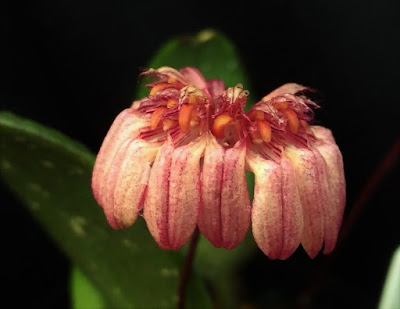Bulbophyllum auratum is native to Borneo, the Malaysia Peninsula, Thailand and probably also the Philippines. In Borneo, these plants are found in mixed forests, the main vegetation of which is dipterocarpus, as well as in more open areas in heath thickets at an altitude of 400-1100 m.
Bulbophyllum auratum, also called as The Golden Bulbophyllum, Bulbophyllum borneense, Bulbophyllum campanulatum, Cirrhopetalum auratum, Cirrhopetalum borneense, Cirrhopetalum campanulatum, Cirrhopetalum candelabrum, Phyllorchis aurata, is a species of the genus Bulbophyllum. This species was described by (Lindl.) Rchb.f. in 1861.
IDENTIFY BULBOPHYLLUM AURATUM
Bulbophyllum auratum is native to Borneo, Malaysia, Thailand and probably also the Philippines. In Borneo, these plants are found in Kalimantan, Sabah, Sarawak and Brunei, in mixed forests, where the main vegetation is dipterocarpus, and in the more open areas of the bush - kerangas, at altitudes of 400-1100 m. In Sarawak, they meet at the border with Brunei, from sea level to 1000 m. In Sumatra, they were found in the Bengkulu region, at an altitude of 1000-1200 m. In Malaysia they were found near Sepan, in the state of Selangor, near Tanum in the state of Pahang and near Jengga in the state of Terengganu. In Thailand, they have been met in numerous places on the Thai peninsula.
It is a hot to cool growing epiphyte with a creeping rhizome with 1/4 to 3/4" (1 to 2 cm) between each clustered ovoid, grooved, dark olive pseudobulb carrying a single, apical purplish leaf of 2-12 cm long and 2.1-3.0 cm wide with a blunt apex and the base narrowing into a petiole.
The Golden Bulbophyllum blooms in early spring through the summer on a lateral to erect, slender, basal, to 6" (15 cm) long, purplish inflorescence that carries a solitary umbel of drooping, shoe-shaped, fragrant flowers. The flowers can be white to dark pink, but most often they are pale yellow with scarlet or pink veins and spots, and the lip is dark-scarlet. The strongly concave upper sepals terminates in a long, hairlike outgrowth. The edges of the sepals are wavy and covered with small hairs. The lateral sepals reach a length of 1.6-3.0 cm. They are directed downward and are joined together almost along the entire length. Their outer edges bend inwards. Petals oval with a sharp tip, also have hairs along the edges and outgrowth at the tip. The tongue resembling the tongue is bent downward.
BULBOPHYLLUM AURATUM CARE AND CULTURE
Cultural information should only be used as a guide, and should be to be adapted to suit you. Your physical location; where you grow your plants, how much time you have to devote to their care, and many other factors, will need to be taken into account. Only then can you decide on the cultural methods that best suit you and your plants.
Light:
Bulbophyllum auratum needs a light level of 12000-23000 lux. The light should be filtered or dispersed, and the plant should not be exposed to the midday sun. Strong air movement should be ensured all the time.
Temperature:
Throughout the year the average day temperature is 24-26 ° C, the night 16-17 ° C, and the daily difference is 8-9 ° C.
Humidity:
The Golden Bulbophyllum needs the average humidity of 75-80% throughout the year.
Substrate, growing media:
Bulbophyllum auratum are best grown on boughs with a rough surface or on tree rootstocks with high humidity and may require several waterings during the day of hot, dry weather. These plants can also grow in flat baskets filled with loose, quickly drying ground. Usually it consists of different amounts of water-retaining components, such as perlite or chopped sphagnum added to medium-sized pieces of bark or tree fern fiber.
Repotting:
This species react badly to starting roots. Plants sometimes need even a year to get back to the form before repotting. If the substrate is not laid out and the plant grows out of the container, it can be repotted into a larger container by removing the plant along with the substrate in order to move the root system as little as possible. When repotting is necessary, it is best to do it when new roots begin to grow, because then it will stabilize faster. When the substrate is spread and the plants are soggy for too long, the plants must be repotted immediately.
Watering:
Bulbophyllum auratum should be abundantly watered during active growth, but their roots must be well aerated, and the substrate around the roots can never be desiccated or soggy. At the end of autumn, the amount of water should be gradually reduced.
Fertilizer:
It is recommended to apply weekly 1/4-1/2 doses of fertilizer for orchids. It is possible to use a balanced fertilizer all year round, and it is possible to fertilize with a high content of nitrogen from spring to mid-summer, and then to the end of autumn - with a high content of phosphorus.
Rest period:
In winter, watering and fertilization should be slightly reduced, especially when plants are grown in the conditions of short, darker days. However, they can never dry up completely. Whenever the amount of water decreases, fertilization should also be reduced.















COMMENTS